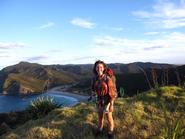
In the warmer seasons in Central New York, rainstorms can be sudden, violent and torrential, soaking students to the skin as they walk across campus. But for Cassidy Jay ’11, rain this summer means more than damp jeans: it means changes in the chemistry of water samples she collects from the Oriskany Basin. She and Associate Professor of Geosciences Todd Rayne are comparing the chemical composition of stream water before and after a rainstorm in the Oriskany Basin.
When rain has not fallen for a while, the water that flows in rivers and streams is called base flow, which is entirely groundwater. During base flow conditions, the chemical composition of the stream water should be controlled by the geology of the rocks and soil that the groundwater moves through on its way to the stream. But once rain falls, the runoff picks up chemicals from the surrounding surface, changing the chemical composition of the water in the streams. The changes in the chemical composition may be related to the way the land in the surrounding area is used; “We’re eventually going to try to relate [the chemistry] to land use,” Jay explained. “For example, if there’s a farm nearby, a higher amount of nitrate from fertilizers may go into the tributaries. We want to see how it influences the composition of the creek.”
In addition to sampling when there has been little rain in order to get the base flow composition, Jay and Professor Rayne will also collect samples after large rainstorms to compare the two. “But during the summer it hardly ever rains over the entire basin all at once; it’s kind of patchy,” Jay observed. “If that doesn’t happen, we will have to wait for bigger rainstorms to come through in the fall.”
To find where they should draw samples from, Jay has been using a computer program called ArcGIS. She uses topography to identify the tributaries in the Oriskany Basin that flow into Oriskany Creek. She has so far identified over 80 locations scattered over the entire basin where she and Professor Rayne intend to collect samples, including several in Oriskany Falls, Waterville, Kirkland, Vernon, Westmoreland, Deansboro and Oriskany, and many more along the back roads in Oneida and Madison Counties. They will try to collect each round of samples in one day in order to get an accurate “snapshot” of the chemical composition of the water.
Upon returning to the lab Jay will run the samples through an ion chromatograph, which identifies the concentrations of cations and anions in the water. From there, Jay will hopefully be able to relate the changes detected in the chromatograph to the use of land in the area where each sample was drawn, which will be part of her senior thesis in geosciences this upcoming year.
When not in the field or the lab, Jay volunteers at the Community Farm Garden and has recently started training for the “90-Miler,” a canoe race in the Adirondacks in September. During the school year she leads trips for the Hamilton Outing Club, is a member of the Nordic Ski Team and is an Adirondack Adventure leader.
Jay is a graduate of Johnsburg Central School in North Creek, N.Y.
When rain has not fallen for a while, the water that flows in rivers and streams is called base flow, which is entirely groundwater. During base flow conditions, the chemical composition of the stream water should be controlled by the geology of the rocks and soil that the groundwater moves through on its way to the stream. But once rain falls, the runoff picks up chemicals from the surrounding surface, changing the chemical composition of the water in the streams. The changes in the chemical composition may be related to the way the land in the surrounding area is used; “We’re eventually going to try to relate [the chemistry] to land use,” Jay explained. “For example, if there’s a farm nearby, a higher amount of nitrate from fertilizers may go into the tributaries. We want to see how it influences the composition of the creek.”
In addition to sampling when there has been little rain in order to get the base flow composition, Jay and Professor Rayne will also collect samples after large rainstorms to compare the two. “But during the summer it hardly ever rains over the entire basin all at once; it’s kind of patchy,” Jay observed. “If that doesn’t happen, we will have to wait for bigger rainstorms to come through in the fall.”
To find where they should draw samples from, Jay has been using a computer program called ArcGIS. She uses topography to identify the tributaries in the Oriskany Basin that flow into Oriskany Creek. She has so far identified over 80 locations scattered over the entire basin where she and Professor Rayne intend to collect samples, including several in Oriskany Falls, Waterville, Kirkland, Vernon, Westmoreland, Deansboro and Oriskany, and many more along the back roads in Oneida and Madison Counties. They will try to collect each round of samples in one day in order to get an accurate “snapshot” of the chemical composition of the water.
Upon returning to the lab Jay will run the samples through an ion chromatograph, which identifies the concentrations of cations and anions in the water. From there, Jay will hopefully be able to relate the changes detected in the chromatograph to the use of land in the area where each sample was drawn, which will be part of her senior thesis in geosciences this upcoming year.
When not in the field or the lab, Jay volunteers at the Community Farm Garden and has recently started training for the “90-Miler,” a canoe race in the Adirondacks in September. During the school year she leads trips for the Hamilton Outing Club, is a member of the Nordic Ski Team and is an Adirondack Adventure leader.
Jay is a graduate of Johnsburg Central School in North Creek, N.Y.
Posted August 18, 2010
